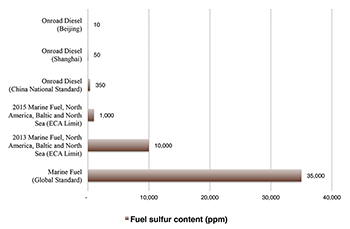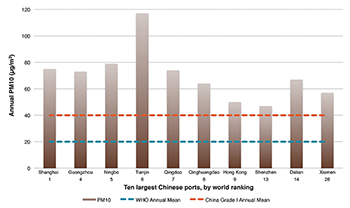Blog
An overlooked contributor to China's recent air-quality woes
Beijing’s recent episode of off-the-charts-bad air quality provoked a remarkable level of worldwide attention. The haze enveloping many Chinese cities, including not only Beijing but also other large and densely populated urban centers like Shanghai and Tianjin, is an environmental and health crisis in motion. Experts point to unfavorable meteorological conditions, lax vehicle and fuel regulations, and coal-fired power generators as explanations, and certainly those factors play their parts. But another culprit in Shanghai and other coastal cities has been receiving comparatively little scrutiny: air pollution from ships.
 Unlike Beijing, Shanghai is surrounded by three major harbor districts, which together constitute the world’s busiest port in terms of its cargo throughput. Ships in these harbors create significant air-quality problems because of their large engines, their high volume of activity, their comparatively low-quality fuels, and their high smog and soot emissions. In contrast to cars, trucks, and buses, pollutant emissions from ships are barely regulated. In China, for example, the maximum permitted level of sulfur in gasoline and diesel for on-road vehicles is 350 ppm (with lower limits in effect in some parts of the country), and now several leading China cities are moving progressively to lower that limit to 50 ppm or even below. In marked contrast, the sulfur level of heavy fuel oil, a marine diesel fuel made from refinery residuals, can be as much as 700 times higher at 35,000 ppm (Figure 1). Such dramatically high sulfur content, of course, directly corresponds to dramatically higher particulate emissions.
Unlike Beijing, Shanghai is surrounded by three major harbor districts, which together constitute the world’s busiest port in terms of its cargo throughput. Ships in these harbors create significant air-quality problems because of their large engines, their high volume of activity, their comparatively low-quality fuels, and their high smog and soot emissions. In contrast to cars, trucks, and buses, pollutant emissions from ships are barely regulated. In China, for example, the maximum permitted level of sulfur in gasoline and diesel for on-road vehicles is 350 ppm (with lower limits in effect in some parts of the country), and now several leading China cities are moving progressively to lower that limit to 50 ppm or even below. In marked contrast, the sulfur level of heavy fuel oil, a marine diesel fuel made from refinery residuals, can be as much as 700 times higher at 35,000 ppm (Figure 1). Such dramatically high sulfur content, of course, directly corresponds to dramatically higher particulate emissions.
The diesel engines that burn this dirty marine fuel are huge, and they emit a huge amount of pollution. On average, the engines of a medium- to large-size container ship (6,000 “twenty-foot equivalent unit”, or TEU) produce about 60 megawatts of power, equivalent to a small electrical power generation plant. The particulate matter churned out in one day from just one vessel that size running at 70% maximum output and using 35,000-ppm sulfur marine fuel equals the emissions from 7300 passenger vehicles in China for an entire year.* And a new vessel arrives in or leaves the port of Shanghai about every 4 minutes—about 135,000 arrivals and departures per year.
 Shanghai is not the only major population center in China next to a big port. Propelled by decades of economic growth, China’s ports are among the world’s busiest. In fact, seven of the world’s ten busiest ports and ten of the thirty largest are in China. Residents of these cities suffer even greater health effects from ships’ pollution than downwind populations that are further inland. Annual PM10 levels in all of China’s ten largest port cities exceeded the standard set by the World Health Organization (WHO) and none of these port cities attained the less stringent Grade I standard that has been set by the China national government (Figure 2). When scientists in Shanghai tried to identify the sources that contributed to its chronically poor air quality—the first such attempt in mainland China—they found that, counting only activity occurring within the jurisdiction of the port, shipping accounted for more than 5.5% of PM and 12% of SOX concentrations in the city. PM2.5 levels in Shanghai–the even finer particulate emissions that are more harmful to human health–are 20 times as high as in the Port of Los Angeles [.pdf], the largest U.S. port, which has enacted more clean port practices.
Shanghai is not the only major population center in China next to a big port. Propelled by decades of economic growth, China’s ports are among the world’s busiest. In fact, seven of the world’s ten busiest ports and ten of the thirty largest are in China. Residents of these cities suffer even greater health effects from ships’ pollution than downwind populations that are further inland. Annual PM10 levels in all of China’s ten largest port cities exceeded the standard set by the World Health Organization (WHO) and none of these port cities attained the less stringent Grade I standard that has been set by the China national government (Figure 2). When scientists in Shanghai tried to identify the sources that contributed to its chronically poor air quality—the first such attempt in mainland China—they found that, counting only activity occurring within the jurisdiction of the port, shipping accounted for more than 5.5% of PM and 12% of SOX concentrations in the city. PM2.5 levels in Shanghai–the even finer particulate emissions that are more harmful to human health–are 20 times as high as in the Port of Los Angeles [.pdf], the largest U.S. port, which has enacted more clean port practices.
Despite their contribution to deteriorating air quality in so many densely populated areas, ships lie generally beyond the current regulatory radar. China’s 12th Five Year Plan, which is the central government’s major planning document and sets out national environmental policy, did not even count shipping in its emission targets. Although the central government began to mandate SOx reduction from power plants [.pdf] in 2006, it paid no attention to these thousands of power plants at sea.
The good news is that implementation of emission control strategies can effect an immediate improvement in air quality. For example, if the above-mentioned 6,000 TEU ship uses marine diesel oil with 10,000 ppm sulfur just for one day, the PM2.5 reduction would be equivalent to taking 3,400 passenger vehicles off the road for an entire year.
One measure used internationally to reduce the sulfur content in marine fuels is the establishment of Emission Control Areas (ECAs), an approach currently being tried in coastal regions of North America and parts of Europe. Ships operating in these areas are required to use fuel with much lower sulfur content—though by no means does that mean low sulfur: concentrations up to 10,000 ppm are currently permitted, a limit that will drop by 90% in 2015. But ECAs are not the only way to reduce pollutant emissions from ships. There are a variety of emission mitigation technology options available [.pdf], including the use of shore power, scrubbers, and selective catalytic reduction. As a short-term solution, local and central governments could offer incentives to shipping companies to use low sulfur fuel, as ports have successfully done elsewhere (like here and here). Just as the Chinese government has moved toward cleaner vehicle fuels, tougher vehicle tailpipe standards, and emission controls for power plants, there are many opportunities to do the same for those thousands of power plants at sea.
*PM emission factor from shipping (g/kW-hr) is calculated from EPA (2009) “Current methodologies in preparing mobile source port-related emission inventories”; PM emission factor in Shanghai was assumed to be 0.015 g/km; annual km of a typical passenger vehicle is about 15,000 km.